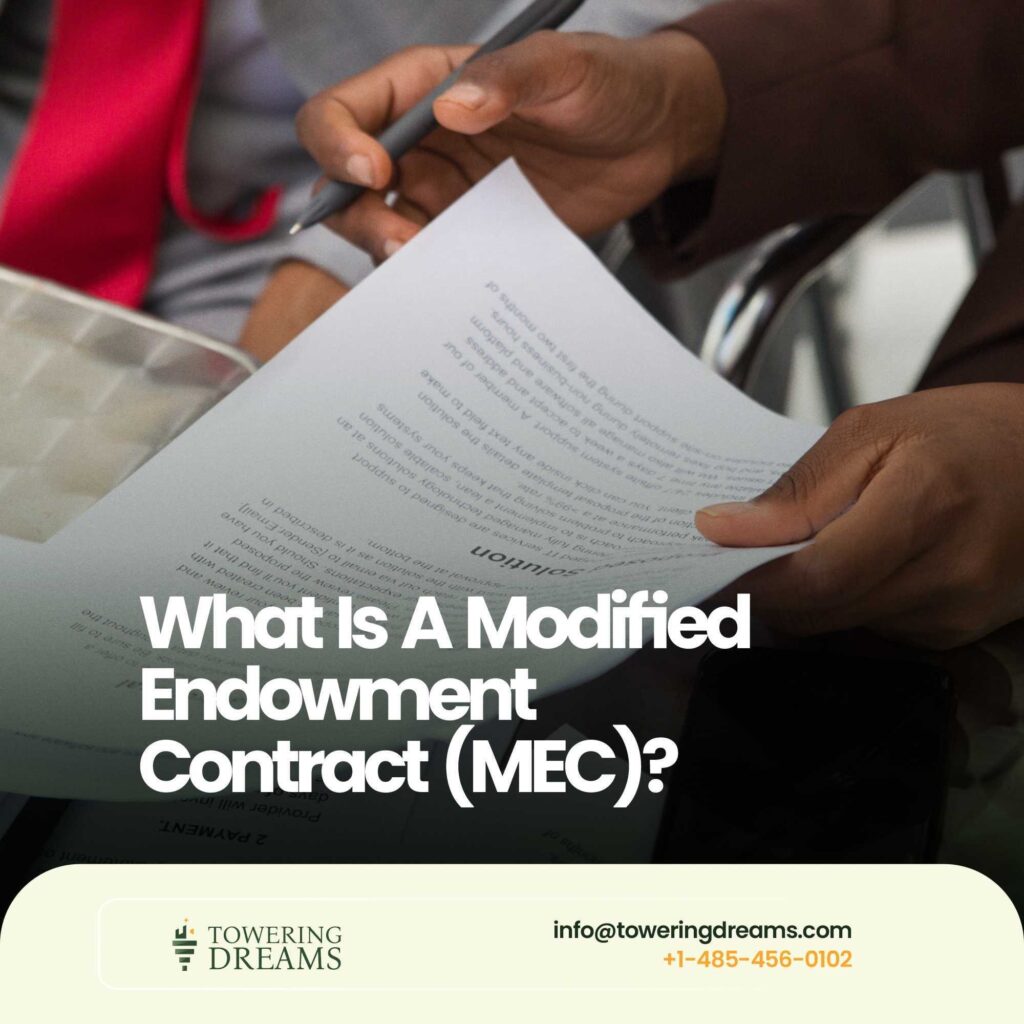
If you’re exploring permanent life insurance as a wealth-building tool, you’ve probably encountered warnings about something called a Modified Endowment Contract, or MEC. The term sounds technical and confusing, but understanding it is absolutely crucial if you’re considering using life insurance for anything beyond basic death benefit protection.
Here’s the basic idea: The IRS created MEC rules to prevent people from using life insurance policies primarily as tax shelters rather than insurance. When a life insurance policy becomes a MEC, it loses some of its most attractive tax benefits—specifically, the ability to access cash value without triggering immediate taxation.
For people who plan to use their life insurance cash value during their lifetime—whether for retirement income, emergency funds, or other financial needs—having a policy classified as a MEC can be financially devastating. It transforms what you thought was a tax-advantaged asset into something that works more like a regular investment account.
But here’s the thing: MEC status isn’t necessarily bad for everyone. If you’re only concerned about the death benefit and never plan to touch the cash value while living, MEC status might not matter to you at all. The key is understanding what triggers MEC classification, what it means for your specific situation, and how to avoid it if that’s your goal.
Summary
A Modified Endowment Contract (MEC) is a life insurance policy that has received too much premium too quickly, failing the IRS’s 7-pay test designed to ensure policies remain true insurance rather than investment vehicles. When a policy becomes a MEC, withdrawals and loans are taxed as ordinary income on a last-in-first-out (LIFO) basis, and distributions before age 59½ incur a 10% early withdrawal penalty. The death benefit remains income-tax-free, but the living benefits are significantly diminished. MEC status is triggered by exceeding premium limits during the first seven years or through certain policy modifications. Once classified as a MEC, the status is permanent and irreversible. Understanding MEC rules is essential for anyone using life insurance for cash value accumulation, retirement planning, or wealth transfer strategies, as proper structuring can maximize tax benefits while MEC violations can undermine entire financial plans.
The History Behind MEC Rules

To understand MECs, it helps to know why Congress created these rules in the first place.
Before 1988, life insurance was becoming an increasingly popular tax shelter. Wealthy individuals discovered they could dump large sums of money into life insurance policies, let it grow tax-deferred, and then take tax-free loans against the cash value. Essentially, they were using life insurance as a tax-advantaged investment account with minimal actual insurance benefit.
Congress decided this violated the intent of life insurance tax benefits, which were meant to encourage people to protect their families, not to create investment loopholes for the wealthy. So they passed the Technical and Miscellaneous Revenue Act (TAMRA) of 1988, which introduced the MEC rules.
The legislation established a test—called the 7-pay test—that determines whether a life insurance policy is being used primarily for insurance protection or primarily as an investment vehicle. Policies that fail this test are reclassified as Modified Endowment Contracts and lose certain tax privileges.
The goal was straightforward: maintain tax benefits for legitimate life insurance while closing the loophole that allowed life insurance to function primarily as a tax shelter. The result is a balancing act—you can still build substantial cash value in life insurance and access it tax-favorably, but there are limits to how quickly you can fund a policy.
Understanding this historical context helps clarify why the rules exist and why they’re structured the way they are. The IRS isn’t trying to make life insurance less attractive—they’re simply enforcing a distinction between insurance and investment.
The 7-Pay Test Explained

The heart of MEC rules is the 7-pay test, which sounds more complicated than it actually is.
Here’s the basic concept: The IRS calculates the maximum premium you could pay over seven years to endow your policy—meaning to fully fund it so it becomes paid up. This calculation considers your age, the death benefit, and policy specifics. If your cumulative premiums during any seven-year period exceed this calculated limit, your policy becomes a MEC.
The test applies during the first seven years of the policy and continues on a rolling seven-year basis throughout the policy’s life. This means even established policies can become MECs if you suddenly increase premiums or make certain policy changes that trigger a recalculation.
For example, imagine the 7-pay limit for your policy is calculated at $10,000 annually, or $70,000 total over seven years. As long as your cumulative premiums stay at or below this amount during the measured period, you’re safe. But if you pay $80,000 in premiums during those seven years, you’ve exceeded the limit and triggered MEC status.
The calculation isn’t something most people can do themselves—it requires specific actuarial formulas. Your insurance company tracks this automatically and will typically warn you if you’re approaching the MEC limit. Most insurance illustrations show the MEC threshold clearly so you can structure premiums appropriately.
Different policy types have different 7-pay limits. A policy with a larger death benefit relative to premium has more room for funding before hitting MEC limits. This is why people who want to maximize cash value accumulation often choose higher death benefits than their pure insurance need would require—it creates more premium capacity under the MEC rules.
It’s worth noting that the test measures premiums paid, not cash value accumulated. Even if your cash value grows substantially through good investment performance, that growth doesn’t count toward the MEC limit. Only the actual premium dollars you contribute matter for the test.
What Happens When a Policy Becomes a MEC

Understanding the consequences of MEC status is crucial for making informed decisions about your life insurance strategy.
The most significant change is how withdrawals and loans are taxed. In a non-MEC policy, you can withdraw up to your basis (the amount you’ve paid in premiums) tax-free, and loans are generally not taxable events. In a MEC, withdrawals are taxed on a LIFO basis—last in, first out. This means all the growth and earnings come out first and are taxed as ordinary income before you can access your basis tax-free.
For example, if you’ve paid $50,000 in premiums and your cash value has grown to $80,000, the first $30,000 you withdraw from a MEC is fully taxable as ordinary income. In a non-MEC policy, you could access that $50,000 basis completely tax-free through withdrawals, and typically access the growth tax-free through loans.
The early withdrawal penalty adds insult to injury. If you’re under age 59½ when you take distributions from a MEC, you face a 10% penalty on the taxable portion, just like early withdrawals from a 401(k) or IRA. This makes MECs particularly problematic if you’re planning to access cash value before traditional retirement age.
Policy loans from MECs are treated as taxable distributions up to the amount of gain in the policy. This is drastically different from non-MEC policies where loans generally aren’t taxable events at all. This effectively eliminates one of the primary benefits people seek from permanent life insurance—tax-free access to cash value.
However—and this is important—the death benefit remains income-tax-free even for MECs. If you die and your beneficiaries receive the death benefit, they don’t pay income tax on it regardless of MEC status. The tax disadvantages of a MEC only affect living distributions.
MEC status is permanent and irreversible. Once your policy crosses that line, there’s no way to undo it. You can’t simply stop paying premiums and wait for it to revert to non-MEC status. This permanence makes prevention critical—you can’t fix a MEC mistake later.
What Triggers MEC Status

Beyond simply paying too much premium, several specific actions can trigger MEC classification.
Excessive premium payments during the first seven years are the most common trigger. If you get enthusiastic about funding your policy and exceed the calculated limits, you’ve created a MEC. This often happens when people try to “max out” their policy without understanding the thresholds.
Material changes to the policy can trigger a new 7-pay test, even years after the policy was issued. Increasing the death benefit, adding riders, or making certain other modifications restart the testing period. If the policy doesn’t meet the test under the new terms, it becomes a MEC.
Exchanging policies through a 1035 exchange can create MEC issues. If you’re exchanging an old policy for a new one and the new policy’s structure doesn’t accommodate the transferred cash value within its 7-pay limits, the new policy immediately becomes a MEC.
Reducing the death benefit can also trigger MEC status. If you decrease the death benefit, the 7-pay limit recalculates based on the new, lower benefit. The premiums you’ve already paid might now exceed the new limit, instantly converting your policy to a MEC.
Loans and withdrawals that cause the death benefit to decrease might trigger recalculation in some policy types, particularly universal life policies with corridor rules that require a minimum ratio of death benefit to cash value.
The good news is that insurance companies monitor this closely. Most will send warnings if you’re approaching MEC limits or if a requested change would trigger MEC status. They’re motivated to help you avoid this because MEC policies are less attractive to consumers, meaning more lapses and fewer satisfied customers.
Who Should Care About MEC Status

MEC rules don’t matter equally to everyone with life insurance. Understanding whether you should be concerned depends on your strategy and goals.
If you’re planning to access cash value during your lifetime, MEC status is critical. People using life insurance for retirement income supplementation, emergency funds, or other living benefits absolutely need to avoid MEC classification. The tax penalties essentially eliminate the advantages they’re seeking.
Those maximizing cash value accumulation need to be particularly careful. If you’re intentionally overfunding a policy to build tax-advantaged wealth, staying under the MEC limit while maximizing premiums requires careful planning and ongoing monitoring.
Business owners using life insurance for executive benefits, key person insurance, or buy-sell agreements should understand MEC implications. Depending on the specific strategy, MEC status might or might not matter, but it’s essential to structure things correctly from the beginning.
High-net-worth individuals using life insurance for estate planning need to consider MEC rules. While the death benefit remains tax-free regardless of MEC status, the flexibility to access cash value during life might be valuable, making MEC avoidance worthwhile.
Conversely, if you’re only concerned about leaving a death benefit and never plan to touch the cash value while living, MEC status might not matter. The death benefit is still income-tax-free, and the living tax penalties are irrelevant if you never take distributions. Some people even intentionally structure policies as MECs to maximize death benefit relative to premium when they have zero intention of accessing cash value.
Younger policyholders typically care more about MEC status because they have decades during which they might want to access cash value. Older individuals purchasing insurance primarily for estate transfer might care less.
How to Avoid MEC Status

If maintaining non-MEC status is important to your strategy, several approaches help you stay compliant while maximizing the policy’s benefits.
Work with a knowledgeable agent or advisor who understands MEC rules and can structure your policy appropriately from the beginning. The initial design is crucial—choosing the right death benefit relative to your premium goals creates the maximum funding room while staying safe.
Stay well below the MEC limit rather than cutting it close. Many advisors recommend staying at least 10-15% below the calculated threshold to provide a cushion for unexpected changes or calculation variations. This buffer prevents accidental violations.
Request MEC illustrations annually showing your current position relative to the limit. Your insurance company can provide reports showing how much premium capacity remains. Review these before making any additional premium payments.
Be cautious about policy modifications. Before increasing or decreasing death benefits, adding riders, or making other changes, understand the MEC implications. Have your insurance company or advisor run projections showing how the change affects your 7-pay test status.
Plan premium payments strategically over the seven-year period. Don’t front-load excessively in early years if you think you might want to add more premium later. Spread premiums to maintain flexibility while maximizing the policy within MEC constraints.
Consider multiple policies if you want to invest more than one policy can accommodate within MEC limits. Rather than stuffing too much premium into a single policy and triggering MEC status, you can spread premiums across multiple policies, each staying safely within its own limits.
Monitor automatically. Some insurance companies offer monitoring services that alert you if you’re approaching MEC limits. Take advantage of these tools to prevent accidental violations.
MEC vs. Non-MEC: A Direct Comparison

Seeing the differences side-by-side clarifies what’s at stake with MEC classification.
Taxation of withdrawals: Non-MEC policies allow you to withdraw up to your basis tax-free (first-in-first-out). MEC policies tax withdrawals as ordinary income until all gains are distributed (last-in-first-out).
Policy loans: Non-MEC loans are generally not taxable events. MEC loans are treated as taxable distributions up to the gain in the policy.
Early distribution penalty: Non-MEC policies have no early withdrawal penalty. MEC policies impose a 10% penalty on taxable distributions before age 59½.
Death benefit: Both MEC and non-MEC policies provide income-tax-free death benefits to beneficiaries.
Premium flexibility: Non-MEC policies have limits on how much premium you can pay without triggering MEC status. MEC policies have no such restrictions—once you’re a MEC, you can pay unlimited premiums (subject to company maximums).
Cash value accumulation: Both can build substantial cash value. MECs might accumulate slightly more since you can pay higher premiums without restriction, though the tax disadvantages on access often outweigh this advantage.
Use for retirement income: Non-MEC policies excel at providing tax-free retirement income through loans. MEC policies are poor choices for this purpose due to taxation.
Estate planning: Both work for estate transfer since death benefits are tax-free regardless. MECs might provide more death benefit per premium dollar if lifetime access isn’t needed.
The bottom line: Non-MEC status preserves flexibility and tax advantages for lifetime use, while MEC status is only acceptable if you never plan to access cash value before death. You can book a free strategy session with us. We will be glad to help,you set up a policy and to help you make the most of it to achieve your aims and objectives.
Conclusion
Modified Endowment Contracts represent a line in the sand drawn by the IRS between legitimate life insurance and tax shelters disguised as insurance. Understanding this distinction is essential for anyone using permanent life insurance as more than simple death benefit protection.
For those planning to access cash value during their lifetime—whether for retirement income, emergencies, or other needs—avoiding MEC status is absolutely critical. The tax consequences of MEC classification can undermine your entire strategy, turning what should be a tax-advantaged asset into a tax trap.
The good news is that with proper planning and professional guidance, staying within MEC limits while maximizing your policy’s benefits is entirely achievable. The key is understanding the rules, structuring your policy correctly from the start, and monitoring it carefully as circumstances change.
Don’t let MEC rules scare you away from using life insurance as a financial tool. They’re simply guardrails ensuring you use it appropriately. Work with knowledgeable professionals, ask questions, review illustrations carefully, and make sure your policy structure aligns with your goals.
If you’re already considering life insurance for wealth accumulation or retirement planning, make MEC avoidance a central part of your strategy. If you’re unsure whether your existing policy might be approaching MEC status, request a current illustration and review your position. And if you’re working with an insurance agent who doesn’t thoroughly understand MEC rules, find one who does—this is too important to get wrong.
Life insurance remains one of the most powerful financial tools available when used correctly. Understanding MECs is simply part of using that tool properly and maximizing its benefits for your specific situation.
Indexed Universal Life Insurance(IUL) policies have a lot of features that can potentially provide a safety net for you and for your loved ones. You should check out this video on how to safeguard your future and that of your loved ones against unforseen circumstances like job loss or illnesses.
FAQs
Question 1: Can a policy that becomes a MEC ever revert to non-MEC status?
Answer: No. Once a policy is classified as a MEC, the status is permanent and irreversible for the life of that policy. You cannot undo MEC status by stopping premium payments, waiting a certain period, or making policy changes. This permanence is why prevention is so critical—there’s no fixing a MEC mistake after it happens.
Question 2: If I have a MEC, should I surrender it and get a new policy?
Answer: Not necessarily. Surrendering a MEC triggers taxation on all gains, which could result in a substantial tax bill. Additionally, starting a new policy means new surrender charges, underwriting, and potentially higher premiums due to increased age. Evaluate your specific situation with a financial advisor or tax professional before making changes. Sometimes keeping the MEC and simply not taking distributions is the best option.
Question 3: Do term life insurance policies have MEC rules?
Answer: No. Term life insurance has no cash value, so MEC rules are irrelevant. MECs only apply to permanent life insurance policies with cash value components—whole life, universal life, variable life, and indexed universal life. Term insurance is purely death benefit protection, so Congress had no reason to restrict it with MEC rules.
Question 4: Can I have one MEC policy and one non-MEC policy simultaneously?
Answer: Yes. MEC status applies policy-by-policy, not to your entire insurance portfolio. You could have multiple policies, some structured as MECs and others carefully maintained as non-MECs, each serving different purposes in your financial plan. This strategy might make sense if you want maximum death benefit in one policy (MEC) and tax-free access in another (non-MEC).
Question 5: Will my insurance company notify me before my policy becomes a MEC?
Answer: Most reputable insurance companies have systems that flag accounts approaching MEC limits and will notify you before accepting premium payments that would trigger MEC status. However, the ultimate responsibility for monitoring MEC status rests with you and your advisor. Don’t rely solely on the insurance company—proactively request annual MEC reports and review your position regularly, especially before making additional premium payments or policy changes.

At Towering Dreams we help American families to choose the right type of Indexed Universal Life ( IUL ) & Annuity plan.
